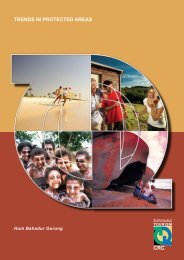icolls - Sustainable Tourism CRC
icolls - Sustainable Tourism CRC
icolls - Sustainable Tourism CRC
Create successful ePaper yourself
Turn your PDF publications into a flip-book with our unique Google optimized e-Paper software.
ECOLOGY, THREATS AND MANAGEMENT OPTIONS FOR SMALL ESTUARIES AND ICOLLS<br />
Sampling Methods<br />
38<br />
Table 7: Physical properties recorded at the time of sampling for each location<br />
Belongil Ck. (High Tide) Belongil Ck (Low Tide) Tallows Ck<br />
Date/Time 10/12/03. 11am 10/12/03. 1.30pm 15/12/03. 11am<br />
pH 7.91 7.98 7.9<br />
DO 6.74ppM 6.03ppM 5.21<br />
Temp. 24.6 o C 28.6 o C 26.4 o C<br />
Cond. 47.9mS 44.6mS 10.2mS<br />
Salinity 29.0ppK 26.9ppK 5.62ppK<br />
Fish were collected using a 20m seine net with 6mm mesh trawled over predominately sandy substrates in close<br />
proximity to littoral vegetation and submerged structures and debris. Seine trawls were conducted between<br />
9:00am and 2:00pm on each sampling occasion. Captured fish were removed from the net after each trawl and<br />
placed immediately into an ice-slurry for transportation back to the laboratory for processing. Sampling of<br />
potential prey items was also conducted using a dip net and a small seine net with a mesh size < 2mm. All<br />
components of the food web were sampled across a range of habitat types representing those available at each<br />
site. Sampling protocols were identical to those outlined in Chapters 2 and 3.<br />
Sample Processing<br />
The total length of each fish was measured and recorded in the laboratory to the nearest 5mm at the conclusion<br />
of each field collection. The gut contents of each fish were removed and preserved in 4% formalin. Gutted fish<br />
were frozen for proposed tissue sampling for stable isotope analyses of trophic relations (following the methods<br />
detailed in Chapters 2 and 3). Two days prior to microscopic investigation the preserved stomach contents were<br />
transferred to a solution of 70% ethanol.<br />
Before ingested items were removed, the gut cavity contents were dried with blotting paper and excess<br />
ethanol allowed to evaporate before being weighed in grams to two decimal places. The entire contents of the<br />
digestive tract were removed by dissection and placed in a Petri dish with 70% ethanol. The contents were then<br />
sorted taxonomically under a Wild M3Z dissecting microscope (6.5-40X). Prey items were recorded under nine<br />
broad dietary categories adapted from existing literature and personal observation of possible prey items found in<br />
the food web sampling.<br />
Dietary Analysis<br />
Gut contents analyses<br />
The dietary analyses utilised three main parameters proposed by Hyslop (1980). These methods have been<br />
widely adopted for the analysis of teleost diets (Edgar & Shaw 1995; Hyndes, Platell & Potter 1997; Sarre,<br />
Platell & Potter 2000; Schafer et al. 2002) and therefore facilitated comparisons between studies. The percent<br />
frequency of occurrence of each dietary item in the stomachs of all fish and the relative contributions of each<br />
dietary item to the number and volume in the stomach of each fish were calculated. Volumes of dietary<br />
categories were calculated indirectly, whereby the items within each diet category were pooled and their<br />
percentage contribution estimated against a standard 1mm grid. This method takes into account the stomach<br />
fullness of each individual analysed (Hyslop 1980). Gut content analyses were restricted to those individuals<br />
whose stomachs contained dietary items at the time of capture. However, individuals with no gut contents were<br />
still included in the isotopic analyses of diet composition, as this method uses muscle tissue as an integrated<br />
measure of diet over a longer period of time than instantaneous gut content methods (Jones & Waldron 2003).<br />
Since volumetric data best represents the relative importance of each dietary category, especially when a<br />
combination of both large and small prey items are eaten that may over- or under-emphasise their importance<br />
(Hyslop 1980), subsequent analyses were performed using only volumetric data for each dietary category. The<br />
use of the volumetric contribution also allows amorphous food items such as algae and detritus to be included for<br />
analysis (Hyslop 1980). Furthermore, comparison of diet reconstructions using gut contents and stable isotope<br />
methods is facilitated using this parameter (Jones & Waldron 2003).<br />
Indices of diversity (Shannon-Wiener, H`) and evenness (J) were calculated to examine the dietary breadth of<br />
each species at each location (Marshall & Elliot 1997). These indices have been widely used to assess teleost











